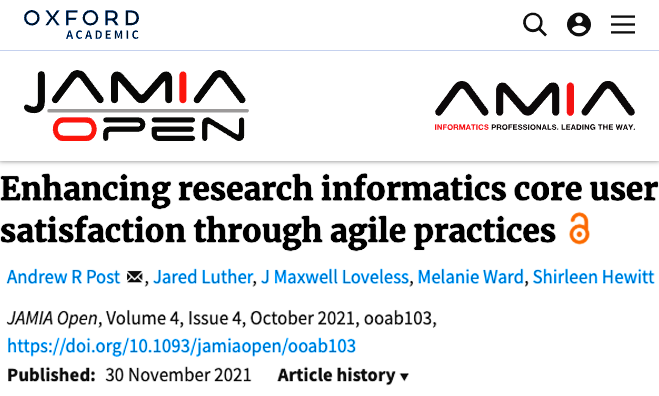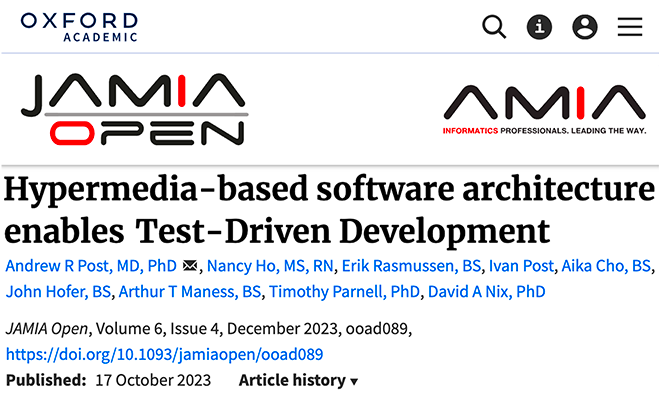- Welcome
- Introduction
- Publications and presentations
- Signing in
- System requirements
-
How To
- Logging into GNomEx
- Submitting an experiment request
- Submitting a microarray hybridization request
- Submitting a sample quality request
- Submitting a sequencing request
- Requesting that microarray hybridization or sequencing be performed on samples previously submitted to sample quality testing
- Adding lanes to a previously submitted sequencing request
- Registering an external experiment in GNomEx
- Finding and viewing a summary of an experiment
- Editing an experiment
- Downloading experiment results
- Linking the samples from an experiment to their BST sample
- Viewing analyses
- Downloading analyzed data files
- Viewing a description of the materials and the methods used during processing of a specific kind of experiment
- Performing a search for experiments and analyses meeting a specific type of criteria
- Submitting a work authorization
- How pricing and billing works in GNomEx
- Adding a new price criterion
- Creating a new price sheet
- Creating a new price category
- Modifying an existing price sheet
- Modifying an existing price category
- Modifying an existing charge item
- Preparing and sending out invoices for clients
- Generating general ledger interface data for automatically billing university accounts
- Window, Tab, and Field Descriptions
-
GNomEx Error Messages and Information Windows
- Are you sure you want to delete all the hybridizations?
- Are you sure you want to delete all of the samples?
- At least one non-empty file must be selected in order for download to proceed.
- Please enter all of the required fields for the hybridization.
- Please enter all required fields for the samples.
- Please enter at least one search criterion.
- Please select a price category.
- Please select a price sheet.
- Remove all hybs currently showing in the list?
- Remove all samples currently showing in the list?
- The number of samples to setup has changed. Do you want to clear out the existing samples?
- The request has not been saved. Are you sure you want to quit?
- The request is now assigned to project.
- The webpage you are viewing is trying to close the window.
- Unable to generate GL interface. Cannot find approved folder.
- You are no longer logged on. Please logon again.
- Your changes have not been saved. Are you sure you want to exit?
-
Working With the List of Samples Submitting for Microarray Hybridization
- Adding a Sample to the List of Samples You Will Be Submitting for Microarray Hybridization
- Adding a sample to the list of samples you will be submitting for microarray hybridization that is similar to another sample already in the list
- Deleting a sample from the list of samples you will be submitting for microarray hybridization
- Deleting all of the samples currently included in the list of samples you will be submitting for microarray hybridization
-
Working With the List of Hybridizations By Requests
- Adding a hybridization to the list of hybridizations you will be requesting
- Adding a hybridization to the list of hybridizations you will be requesting that is similar to another hybridization already in the list
- Deleting a hybridization from the list of hybridizations you will be requesting
- Deleting all of the hybridizations currently included in the list of hybridizations you will be requesting
- Editing a hybridization from the list of hybridizations you will be requesting
- Working with the list of hybridizations you will be requesting
- The hybs tab (submit microarray hybridization request window)
- The submit microarray hybridization request window
- Submitting a microarray hybridization request
- Microarray hybridization requests
-
Specialized Role Topics
- Uploading a sample sheet
- Setting/changing the prices of a charge item
- Setting/changing the experiment type(s) associated with a price sheet
- Setting/changing the criteria by which a charge item will be applied to billing for an experiment
- The sample view tab (new experiment module)
- The hyb setup tab (new experiment request module)
- The hyb view tab (new experiment request module)
- The new project window
- The edit project window
- Adding a new project while you are entering a microarray hybridization request
- Editing an existing project while entering a microarray hybridization request
- Adding a new sample characteristic for annotation while submitting a sample hybridization
- Editing an existing sample characteristic for annotation while submitting a sample hybridization
-
Guides
- User Guide
- Experiment orders
- The foundation of GNomEx
- Experiments at a glance
- Submitting a HiSeq or MiSeq experiment order
- ABI Capillary (Sanger) Sequencing
- Checking on experiment progress
- Copy and pasting into samples grid
- Posting outside experiment data
- iScan experiments
- Downloading and uploading your data
- The download files window
- Downloading large data sets
- Downloading chromatograms
- Fast data transfer from the command line
- Troubleshooting guide for downloading
- Launching FDT with Webstart
- Uploading your data
- Annotating your experiment
- Associating experiment files back to the samples
- Sample annotations
- Copy and paste for the samples grid
- Bulk sample sheet import
- Analysis and data tracks
- Create an analysis
- Data tracks
- Disk usage
- Configuring GNomEx
- Context-sensitive help
- Customize the billing account fields
- Dictionaries
- Seq lib protocols and barcode schemes
- Configuring HiSeq rapid mode sequencing options
- Developer Guide
- Installation Guide
- Configuring GNomEx for FDT
- Configuring GNomEx to use LDAP Authentication
- Compiling and Building
- The Database Schema
- GNomEx Open Source
- Developer Documents
- Illumina HiSeq Realtime Info — The Metrix Server
- FAQs
- Demo
The Hybs tab on the Submit Microarray Hybridization Request window is used to enter unique details about each of the hybridizations that you are requesting.
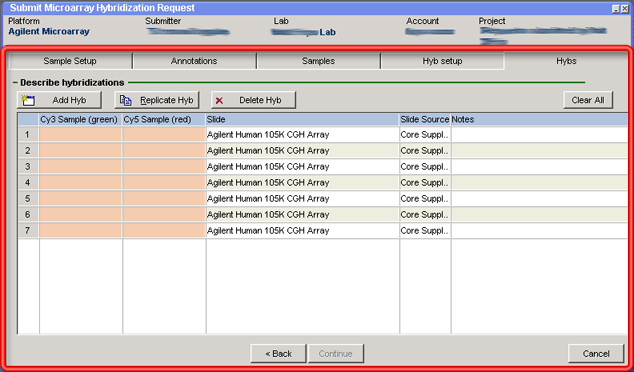
Most of the tab is taken up by a grid in which are listed each of the hybridizations to be requested (one hybridization per row in the grid).
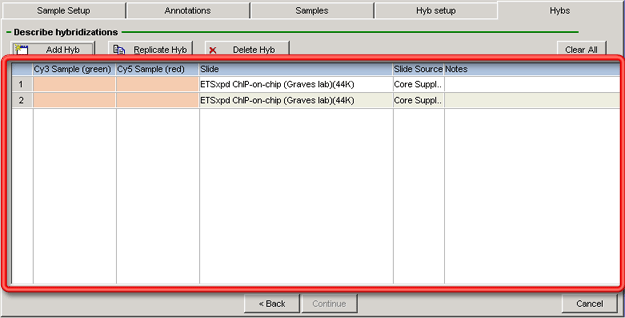
The number of hybridizations displayed in the Hybridizations grid when you first access this tab depends on the values entered in parts D (D. Select the microarray slide or slide set to be used for these hybridizations)and E (E. How many hybridizations will you be requesting?) on the Hyb Setup tab.
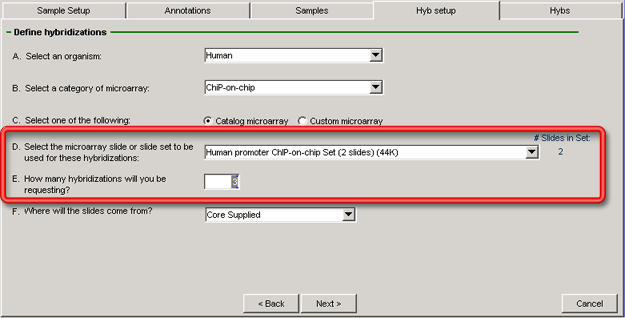
If you go back to the Hyb Setup tab and change this value, then return to the Hybs tab, GNomEx will automatically add hybridizations as appropriate to reflect these changes. It currently will not automatically remove any hybridizations if the values entered on the Hyb Setup tab indicate that there are too many in the grid, although this behavior may change in a future release of the application.
You can add or delete hybridizations (rows) in the grid independent of the value entered on the Hyb Setup tab — see Working With the List of Hybridizations You Will Be Requesting. Buttons are provided to the left above the grid for this purpose. The Add Hyb button adds a new hybridization using the default values established for your hybridizations — see Adding a Hybridization to the List of Hybridizations You Will Be Requesting.
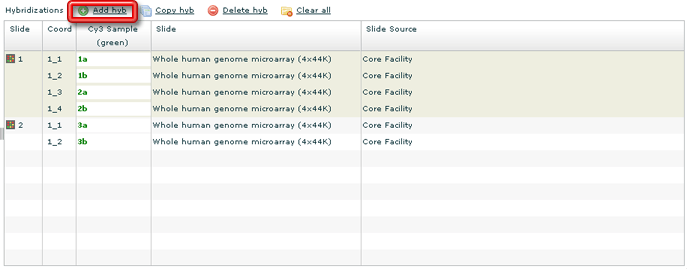
The Delete Hyb button removes a selected hybridization from the grid — see Deleting a Hybridization from the List of Hybridizations You Will Be Requesting.
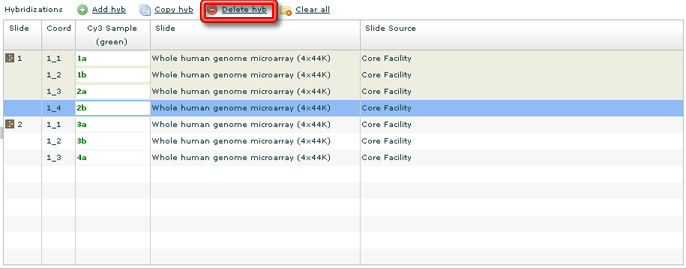
The Replicate Hyb button creates a new hybridization in the grid, using as its defaults the current values of a selected sample, regardless of whether these values match the defaults entered on the Hyb Setup tab or not — see Adding a Hybridization to the List of Hybridizations You Will Be Requesting that is Similar to Another Hybridization Already in the List.
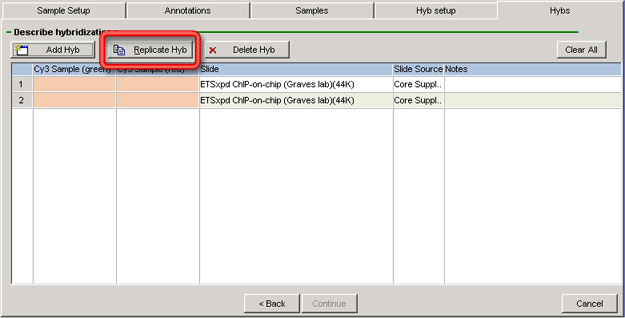
(These last two buttons will not function if a sample is not selected in the grid.) Another button (Clear All) is provided above the grid to the right to remove all of the hybridizations currently listed in the grid — see Deleting All of the Hybridizations Currently Included in the List of Hybridizations You Will Be Requesting.
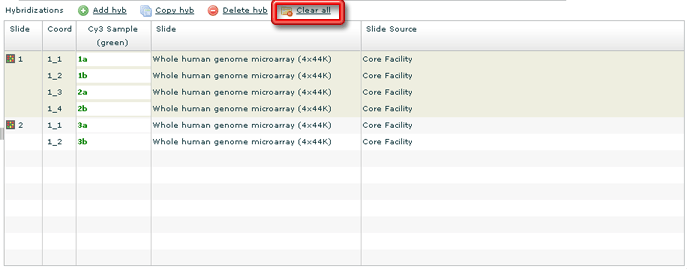
Hybridization settings can be edited directly in the grid itself by clicking on the appropriate column and making the necessary changes — see Editing a Hybridization from the List of Hybridizations You Will Be Requesting.
The first couple of columns in the grid are for identifying the samples to be used in the hybridization process. The first column is for selecting the Cy3 Sample (green) and the second is for the Cy5 Sample (red). In both cases, each field is a drop-down field, the options presented being the various identifiers for the samples entered in the Sample Name column in the grid on the Samples tab. You indicate that a sample is to be used by selecting its identifier in the appropriate field. A sample must be chosen in each of the two columns for every hybridization listed in the grid, as represented by the fact that the fields in this column that do not have a value entered are displayed in pink.
Every required field in the grid that is blank (whether it started as blank or you deleted the value that was in it) will be displayed in this pink color until a value is entered in it.
The next column is either the Slide column or the Slide (in set) column. If the selection in part D (D. Select the microarray slide or slide set to be used for these hybridizations) on the Hyb Setup tab is a single slide, rather than a set of more than one slide, the column heading will say Slide and the value selected in part D will be automatically entered (and uneditable) in this column for all of the hybridizations in the grid. However, if a set of slides has been selected, the column heading will say Slide (in set) and no value will have been automatically entered in the column. You will be expected to specify which slide (in each set) pertains to each hybridization in the grid. This, once again, is a required field, whether a default value has been entered in it or not when you first access the tab.
The following column is the Slide Source column. As a default, the value selected in part F (F. Where will the slides come from?) on the Hyb setup tab is entered in this column for each of the hybridizations in the grid. This field is editable, however, in case the slide for an individual hybridization will come from a different source than the others. Finally, the last column in the grid is a large text field for including any Notes that apply to the individual hybridizations requested.
There are three buttons along the bottom of this tab. The < Back button in the bottom center of the tab automatically moves back to the Hyb Setup tab — see The Hyb Setup Tab (Submit Microarray Hybridization Request Window).
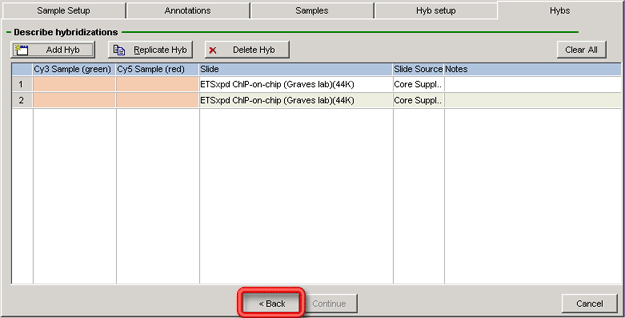
The Continue button closes the window, and opens the Review Request window so that you can perform one final review of your request before finally submitting it to the Microarray Core facility.
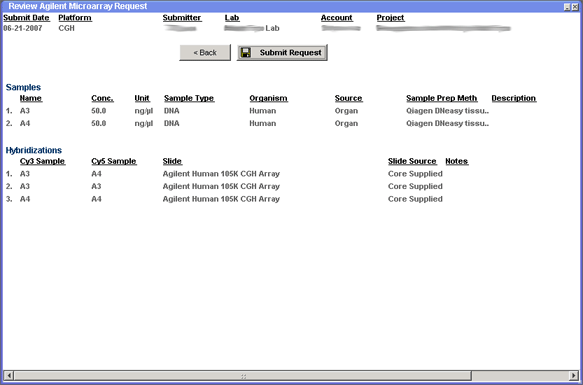
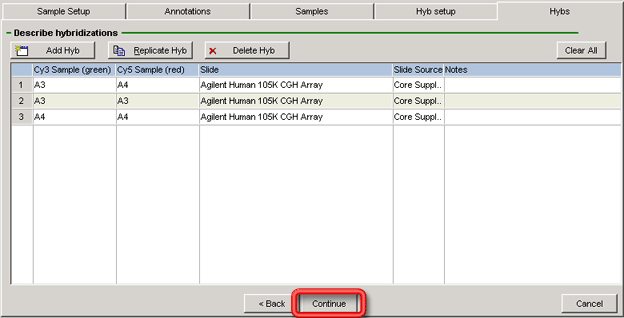
This button only becomes active if all of the required fields in the grid have a value entered in them — in other words, there are no fields colored pink in the grid.
The Cancel button in the lower right corner of the window closes the window without submitting your hybridization request.

If you click on this button, all of the data entered on the window will be lost. Before closing the window, however, a dialog opens to verify that you really want to cancel your request.

Click Yes on this dialog to verify that you really want to close the Submit Microarray Hybridization Request window without submitting a request or No to return to the window and continue with your submission.



